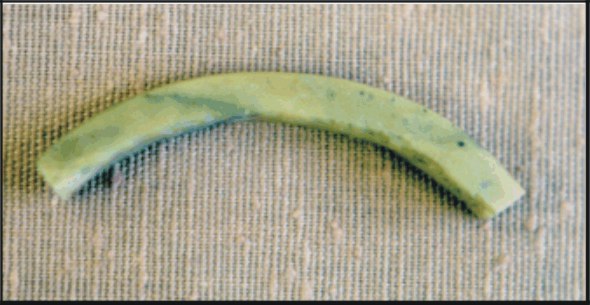AB29
AB29

These beautiful objects must have taken much skill to work. Flint is a fragile stone and such a fine object would have easily been broken in manufacture, or indeed in use. One might wonder therefore if these items were worn everyday or were manufactured for the grave.
Bifacially worked flint bracelets seem to have been manufactured from the Early Dynastic through to the Old Kingdom. A workshop of these artefacts is said to have been located in Wadi el-Sheik (Seton-Karr 1904, 146). It is not clear whether these pieces are finished or would have been polished (Petrie and Quibell 1896, 59, pl. 75, 100; Schmidt 1989, fig. 15, 6). One example only is known from Old Kingdom Tell Ibrahim Awad though the excavator suggested this might be a secondary deposit in view of the usual occurrence of these on Early Dynastic sites (Schmidt 1992, 88, fig. 8.51). The body in tomb M14 at Abydos had seven flint bracelets on the left arm and one on the right (Petrie 1902, Vol. I, 16). Emery (1958, III) states that the 1st Dynasty Saqqara tomb 3507 (possibly the tomb of Her-nit Djer’s queen) contained 8 fragments of flint bracelets and one complete example. Ivory, onyx and schist bracelets were also found.
Petrie (Petrie and Quibell 1896) had the idea that bangles were formed by shaping naturally occurring rings “Nodules of flint are to be found in the limestone presenting a resemblance to Saturn with his ring. When the central boss could be detached, the ring would be used. Commonly, however, it appears that rings were found in the gravel already detached, or the division between the boss and the ring so much reduced by solution of the soluble silica so as to admit of easy separation. The finished rings in section shew [sic] a great change at the surface, greater than their age would warrant if made out of flint directly derived from the rock, though just such an amount as might be expected from flint which had lost part of its silica by exposure to the gravel and becomes porous.’’ There is at least one known example of a flint bracelet which was made from a naturally occurring flint ring which is now in the museum at St Germain-en-Laye (No. 52.651, Beck and Cleyte-Merle 1982, 98). The example is unfortunately undated but is from the Theban area where many naturally shaped rings occur on the west bank.
However, half finished pieces have been found suggesting that this was not the only means of manufacture. Currelly (1913, 272) describes a ‘half of a flat disc of flint in course of preparation for a bracelet; a small hole was started in the Centre.’ In addition, broken discs and unfinished armlets were found at Wadi el Sheik (Rhodes 1970, 8) showing that Egyptian armlets were made by making a disc of the right diameter and then removing the centre by flaking from both sides.
More on flint in ancient Egypt
References
Beck, F. and Cleyet-Merle, J.-J. (1982), Archéologie Comaparée. Catalogue Sommaire des Collections du Musée des Saint-Germain- en-Laye. Collections du Musée Des Antiquities Nationales. Paris.
Currelly, M.T.C., 1913. Catalogue Général des Antiquités Égyptiennes du Musée du Caire. Nos 63001-64906. Stone Implements. Cairo.
Emery, W.B., 1958. Excavations at Saqqara: Great Tombs of the First Dynasty Vol. III London: Geoffrey Cumberlege and Oxford University Press.
Petrie, W.M.F. and Quibell, J.E. 1896. Naqada and Ballas. Warminster: Aris & Phillips : Joel L. Malter.
Petrie, W.M.F., 1902. Excavations at Abydos. London: Royal Anthropological Society.
Rhodes, J.G., 1970. Flint Rings and Egyptain Armlets. Antiquity 44, 145-146.
Schmidt, K., 1989. ‘Die Lithischen Kleinfunde’. In Th. Von Der Way, ed., Tell el-Fara’in Buto. 4. Bericht. MDAIK 45, 300-307.
Schmidt, K., 1992. Tel Ibrahim Awad: Preliminary Report on The Lithic Industries. In Van den Brink, E.C.M. ed., The Nile Delta in Transition 4th-3rd Millenium BC. Proceedings of the Seminar held in Cairo, 21 – 24 October 1990, at the Netherlands Institute of Archaeology and Arabic Studies, Tel Aviv and Jerusalem: Edwin C. M. Van den Brink, 76-96.
Seton-Karr, M.H.W., 1904. Fayum Flint Implements. Annales du service des Antiquites d’Egypte 5, 145-186.